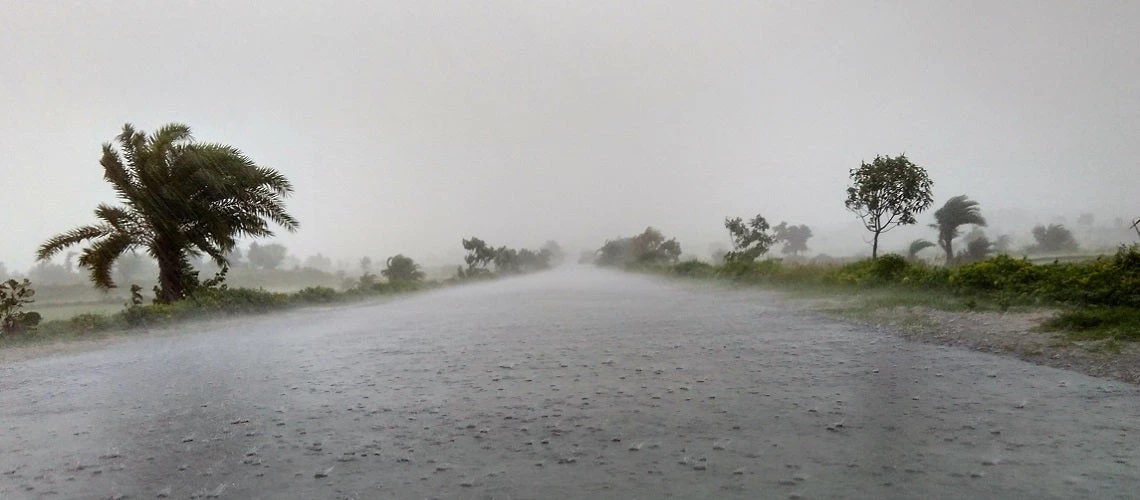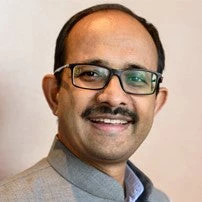 Heavy rain and cyclone storm Amphan at a highway road in Purulia, West Bengal, India
Heavy rain and cyclone storm Amphan at a highway road in Purulia, West Bengal, India
In May and June, in the midst of the outbreak of COVID-19 India experienced two major cyclones. On May 20, super Cyclone Amphan hit the east coast of India, West Bengal and Odisha and parts of Bangledesh. On June 2, Cyclone Nisarga on west coast hit Maharastra.
Managing the competing demands of a lockdown with an evacuation was challenging, but overall human losses were limited to a significant extent.
We aren’t even half way through the cyclone season, but here are five early lessons:
- Revise the Standard Operating Procedures (SOP) for evacuation: Putting people in cyclone shelters and evacuation centers in the context of COVID-19 is extremely challenging. When we apply social distancing measures, the capacity of cyclone shelters is reduced to 40 percent. We need to work with epidemiologists to make risk informed decisions about evacuation procedures. How do we move different groups of people to avoid the risk of cross infection? How do we provide food and water/sanitation facilities in a way that minimizes COVID-19 risks? And ultimately, all these efforts are about strengthening the capcity of communities to help them think through such issues and devise locally appropriate solutions.
- Repurpose existing capacities, resources and tools: When the capacity of cyclone shelters is reduced from 500,000 to 200,000 people, we have to repurpose closed schools and colleges to see where they are situated in terms of risk. And for identifying such resilient assets we have to use the risk assessments undertaken in coastal areas even prior to COVID-19.
- Protect the responders: It doesn’t happen very often that we are in disasters where responders themselves are at a very big risk. Do our responders have access to suitable personal protective equipment? Do responders have quick access to testing? Do we have protocols in place so that they can isolate the whole team if one person is infected? In the aftermath of the first cyclone in May, about 100 responders tested positive, and thankfully, all of them have recovered.
- Reduce any additional burden on hospitals, and preparing them for what is to come: Can we provide on-site medical attention to people affected by the cyclone so that we don’t increase the burden of hospitals which are already treating COVID-19 patients?
- Apply the classic DRM principle, focus on the most vulnerable first: In this case the elderly are the most vulnerable. We’ve already done quite a lot of work on how to take care of the elderly during evacuations. But COVID-19 creates even greater risks for this population. How do we make special provisions for them in the cyclone shelters to reduce their exposure?
Earlier this month, as the co-chair of Global Facility for Disaster Reduction and Recovery (GFDRR), I had the opportunity to participate in the GFDRR-hosted webinar on managing tropical storms during the COVID-19 crisis. I heard inspiring examples of how my peers in similar roles are leading responses in Vanuatu, the Caribbean, and Japan.
At this difficult time, it is heartening to see that more than a decade of investment – including with the support of GFDRR – in building legal and institutional frameworks for disaster risk management is paying off! In Vanuatu and India, and indeed many other countries, classic disaster risk management laws and governance structures have supported the ability of officials to undertake emergency measures and manage not only the response to tropical storms but also the non-pharmacoloigical aspects of the COVID-19 response. At the same time, we are learning that these instruments must be more flexible and able to respond to dynamic situations since conditions are changing constantly, sometimes every week.
Similarly, the investment made in disaster information systems, including open and interoperable data platforms, is paying off. These tools are being used to manage the response to not only tropical storms but also for COVID-19.
Although disaster risk management agencies have worked on hospital preparedness issues before, our interaction with health sector is closer than ever before. In the wake of COVID-19 a clear complementarity in terms of our expertise and role has come to the fore. We need to institutionalise this.
The private sector is playing key roles: in providing supplies, logistics, and back up shelters; in economic recovery; and in adapting industry practices so that people can get back to work safely.
Across all countries, there is no alternative to community leadership. Decentralizing decisions, authority, autonomy, and response is helping communities come together to respond to the unprecendented nature of the current crisis. In many countries and communities, a sense of shared responsibility and solidarity is emerging as people come together to face these challenges.
For disaster risk management professionals, this is a moment to test what we know how to do well, to adapt our tools to this new environment, and to strengthen our commitment to emergency preparedness and response so that we can emerge more resilient than ever.


Join the Conversation